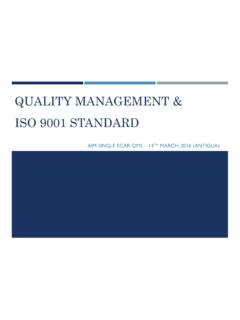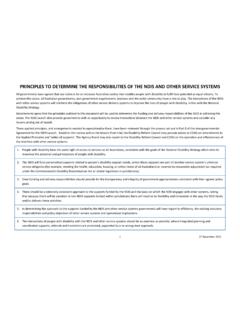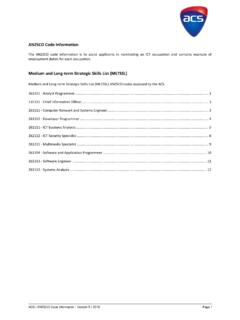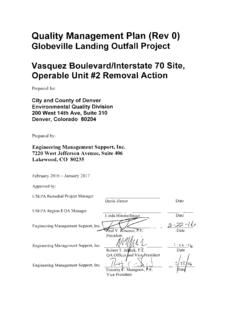Transcription of Preventive Maintenance Guidelines - ncfrpc.org
1 1 Preventive Maintenance Guidelines TYPE I & TYPE II BUSES EXHIBIT 42 Preventive Maintenance Guidelines Table of Contents Introduction 3 Preventive Maintenance Arrangements 3 Daily Bus Maintenance 3 Fuel System Operation 4 Preventative Maintenance Forecast Report 5 Job Descriptions 6 Preventive Maintenance Inspections 14 Bus Type I PM Checklist 17 Bus Type II PM Checklist 19 Maintenance Guidelines 23 A/C Maintenance 27 A/C Preventative Maintenance Checklist 29 Daily Vehicle Inspections 33 Form Daily Vehicle Inspection Checklist Bus Type I 34 Form Daily Vehicle Inspection Checklist Bus Type II 35 General Notes about daily inspections 36 Comprehensive Maintenance Record 36 Warranty Recovery
2 System 36 3 Introduction The City of Gainesville s Regional Transit System (RTS) currently has one (1) Maintenance facility located at 34 SE 13th Road, Gainesville, FL 32601. This site includes fueling infrastructure and a bus wash. RTS has an established and effective Preventative Maintenance program. The elements of this program are formally described in the Preventative Maintenance Plan Preventive Maintenance Arrangements RTS personnel schedule, perform and manage all the activities associated with the Preventative Maintenance program. The following describes the process that is currently in practice for PM scheduling: Vehicle Service Attendants perform daily bus Maintenance activities which are listed below.
3 Daily Bus Maintenance 1. Check for fluid leaks. Inspect underneath the bus for sign of leakage. Visually inspect engine and compartment to include all lines, piping and hoses. 2. Check exterior lights. Make sure all exterior lights are illuminated. 3. Inspect all drive belts. Look for cracks, tears or burns. Check tension. 4. Inspect tires. Check air pressure (120 PSI). Visually inspect for damage and/or unusual wear. 5. Inspect wheels. Look for cracks, damage and loose lugs. 6. Check coolant level. Adjust as required. (Refer to lubrication chart) 7. Check engine oil level. Adjust as required. (Refer to lubrication chart) 4 8.
4 Check transmission level. Adjust as required. (Refer to lubrication chart) 9. Check hydraulic fluid level. Adjust as needed. (Refer to lubrication chart) 10. Fill DEF tank. If applicable. 11. Check air intake restriction indicator. If restriction is indicated advise shift supervisor. 12. Report any defects discovered during service line activities to the shift supervisor Fuel System Operation 1. Pull bus into fueling bay. Follow Instructions found under the Fleetwatch Remote Island Head (RIH). 2. After swiping your badge. Fleetwatch will prompt you to verify vehicle # before uploading vehicle information ( mileage). If vehicle # is correct hit send on RIH 3.
5 Turn pump on and attach fuel nozzle to bus. 4. When fueling is complete turn pump off and hang up hose. 5. Check all fluid levels and make any necessary adjustments, (Fleetwatch turns required fluids on) Lane # Pump # Product 1 1 Diesel Low Sulfur On Road 2 2 Diesel Low Sulfur On Road 3 3 Diesel Low Sulfur On Road 4 4 Diesel Low Sulfur On Road 4 5 Gasoline Unleaded Any defects discovered during the daily bus Maintenance are reported and corrected in conjunction any defects noted on the post trip inspection form. The mileage and fluid usage from bus refueling is uploaded daily from the Fluid Management software, FleetWatch to the Fleet Maintenance Management software FleetNet.
6 A Preventative Maintenance forecast report is generated daily and used to schedule inspections for the following day. 5 The following is an example of the PM forecast report: The selected vehicles are removed from service and Preventative Maintenance work order s are generated and assigned to appropriate personnel. During the inspection RTS personnel uses the PM checklist and notes any defects discovered during the inspection. Once the PM checklist is complete the assigned personnel signs and dates the checklist. If required a work order is then generated and assigned to the appropriate personnel to correct any defects noted on the checklist.
7 The work orders are closed and a copy is printed for the vehicle file and the electronic version remains a part of the permanent vehicle records in the fleet management software. RTS utilizes Fleet Mechanic II, Fleet Mechanic I and Vehicle Service Attendants to perform vehicle Maintenance . All personnel that perform vehicle 6 Maintenance have a minimum of one year of training and/or experience as a mechanic or inspector in a vehicle Maintenance program and has sufficient general knowledge of the vehicles owned and operated by your agency in order to recognize deficiencies or mechanical defects. All RTS personnel performing Maintenance , inspections or repair of buses are knowledgeable of the requirements set forth in Rules 14 , 14 , 14 , Florida Administrative Code.
8 The following are the position descriptions that perform Maintenance and repair vehicles. These positions are listed by experience requirements in a progression to the highest skilled vehicle Maintenance personnel in the RTS organizational structure: VEHICLE SERVICE ATTENDANT NATURE OF WORK Entry level work performing scheduled and unscheduled Maintenance and minor repairs on vehicles including buses. CLASSIFICATION STANDARDS Positions allocated to this classification report to a designated supervisor and work under direct supervision. Work in this class is distinguished from higher classes by its lack of technical skill and from lower classes by its emphasis on vehicle repair and Maintenance .
9 EXAMPLES OF WORK** ESSENTIAL JOB FUNCTIONS Performs daily bus Maintenance and refueling, checking and replenishing fluid levels including engine oil, engine coolant, power steering and transmission Repairs and maintains tires. Makes field tire service calls. Repairs and replaces lights, turn signals, and parts including mirrors, fan belts, and water hoses. Assists mechanics in performing general labor related tasks and repairs of greater complexity. Washes, cleans, and vacuums automobiles, buses, trucks, and other automotive equipment. Performs scheduled and unscheduled Maintenance on automobiles, light trucks, buses and transit equipment in accordance with manufacturers recommendations statutory requirements and departmental policy and procedures.
10 Attends work on continuous and regular basis. 7 NON ESSENTIAL JOB FUNCTIONS Performs emergency road service to vehicles and buses, cleans up petroleum or coolant discharge on the roadway and completes required documentation. Performs general Maintenance duties in and around garage, including cleaning of fueling facility and bus parking areas. Performs other related duties as assigned. MINIMUM REQUIREMENTS Completion of high school or possession of an acceptable equivalency diploma, and one year experience in automotive vehicle or heavy equipment repair and servicing, preferably in a public works or utility fleet, or an equivalent combination of education and experience which provide the required knowledge, skills and abilities.





